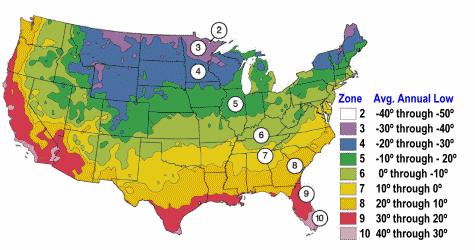Most landscape projects have a purpose and goal that needs to be achieved. Maybe it’s landscape privacy, or a relaxing backyard oasis, or to improve a home’s curb appeal. Whatever the reason, planning before planting is the only way to achieve that goal. Don’t assume any plant of any size will work in any yard. There are 6 key factors to consider before planting.
Hardiness ZONE:
The USDA Plant Hardiness Zone Map is the basis for which gardeners can determine which plants will grow best in their area. The United States is divided into different “zones” in which certain plants will grow best. The zones are numbered from 1-13 with the lower number zones representing colder climates. Minnesota ranges between Zone 2 in Northern Minnesota and Zone 4 in Southern Minnesota. It would be unwise to buy plants rated for Zone 7 when living in Zone 4; The plants would not survive the winter. Before purchasing plants, check the tag on the plant to see what zone it is rated for.

SUN/Shade Condition:
Plants need sunlight to survive; it is important to the photosynthesis process. However, not every plant requires the same amount of sunlight to thrive. Planting a full-sun shrub under a large shade tree is setting that plant up for failure. The same can be said for a shade loving plant being placed in full sun. It will most likely dry out, wilt, and shrivel up from the intense afternoon sun. Monitor your garden to verify how much sun it receives during the day and check the plants to see what their sun/shade requirements are. Each plant has a care label that will tell you if the plant needs full sun, part sun/shade, or shade. To be categorized as a ‘full sun’ the plant requires at least 6 hours of direct sun per day. Partial shade or partial sun means that the plant will need 3-6 hours of direct sun per day.
**Tip to Monitor Sun Light**
Draw a simple diagram of your garden or yard. Over the course of the day, check to see what parts of the garden are shaded or are in full sun. You can either make a note or draw where shadows are cast. Do this every two hours to get a good idea of when, how long, and how intense the sun or shade is.
WATER Preference:
Similar to sun/shade conditions, water preference is important to the overall health of a plant. Some plants prefer moist soil, while some are very drought tolerant. Placing a plant that naturally grows in dry upland regions next to a plant that grows near swamps and streams would be unwise. Factors such as soil type, elevation, and shade coverage all effect the moisture level in the ground. If installing a rain garden, paying attention to the water preference is even more important. Otherwise, installing an irrigation system with drip line would allow the plants to be watered evenly, regularly, and set to a timer that you control.
SOIL Condition:
Good soil is one of the most important factors in supporting healthy plants. If your soil is too sandy, it may not hold water for the plant, or provide enough nutrients. Clay soil may drain slowly and be difficult for roots to get oxygen. Understanding the soil condition is crucial because you may need to amend they soil or choose different plants. The soil can always be amended with compost, organic matter, lime, or other mulch types to achieve better growing conditions. Garden plants grow their best in loam soil that is neutral to slightly acidic. A homeowner can purchase a soil testing kit to determine the composition of the soil.

HEIGHT/WIDTH:
The mature size of plants will be much larger than when first purchased. Perennials, shrubs, and trees alike will continue to grow taller and expand in width. To avoid overcrowding of your beautiful blooms, plant them far enough away from each other and other objects. Take a measurement of landscape beds and window heights to make sure there is enough space for future growth without crowding. If this step is skipped, you’ll wind up having to constantly split plants and trimming back shrubs that are overhanging window, doors, and walkways. When considering plant size, it is wise to imagine the space 3, 5, and 10 years down the road rather than the immediate results.
4 Risks of Planting Before Planning
BLOOM TIME:
If the goal of your garden is to be a summer oasis, then the plants selected should have summer interest. Check the bloom times and bloom length on each plant tag. This might be obvious to you, but what about creating a garden that has seasonal interest year round? The best gardens always manage to have something blooming each season. You don’t want to group all your blooms and colors together because you will be left with gaps within the garden. Try picking plants from a “cheat sheet” like this to ensure a nice variety of blooms every month.




